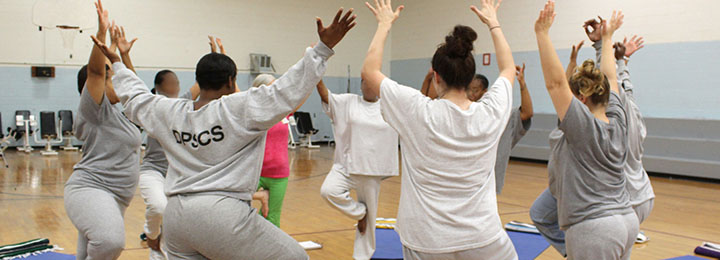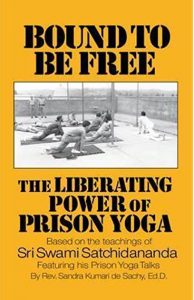 With the popularity of the Netflix series, Orange is the New Black, viewers are given a rare look at what it might be like inside a women’s prison. Recently, I found myself getting a real life look inside a women’s prison. Though I wouldn’t be wearing orange, I knew someone who did and who began a prison ministry many years ago.
With the popularity of the Netflix series, Orange is the New Black, viewers are given a rare look at what it might be like inside a women’s prison. Recently, I found myself getting a real life look inside a women’s prison. Though I wouldn’t be wearing orange, I knew someone who did and who began a prison ministry many years ago.
In the mid-1950s, Sri Gurudev, Swami Satchidananda, founded Satchidananda Thapovanam in Kandy, Sri Lanka. It was at this time that he—clothed in orange dhoti and upper cloth—began his prison ministry, counseling inmates in a minimum-security prison camp not far from the ashram. His service there was so successful that he was asked to meet with the prisoners at the maximum security prison in the area. Eventually, he counseled death row inmates.
In 1966, Swami Satchidananda moved to the USA. Around that time, a young man who had become an Integral Yoga student (we’ll call “Bob”) was awaiting the resolution of a criminal complaint against him. He was found guilty and incarcerated. Of course, the challenges of incarceration were many, but he found that Yoga and meditation helped him get through the initial period of adjustment; and once he settled in, he began to practice Hatha Yoga and meditation in his cell. After a time, his cellmate also began to practice. When Bob was moved to a dormitory, he continued to practice, and a group of ten inmates formed around him. The group met twice a week, once a week for Hatha Yoga and once a week for satsang. At some point, Bob was able to get permission for a teacher from the local Integral Yoga Institute to come once a week. Also, Bob invited Swami Satchidananda to speak with his group, and almost a hundred men attended the talk. Over a twenty-year period, as other Integral Yogis who were teaching in prison invited Gurudev to speak to their students, Gurudev spoke to hundreds of inmates. He gave his last prison talk in 1996 at Buckingham Correctional Center, which is located some twenty miles from Satchidananda Ashram–Yogaville.
My brother, a Siddha Yogi (devotee of Gurumayi, Swami Chidvilasananda), has been teaching meditation in prisons for many years under the auspices of their SYDA Yoga Prison Yoga Program, and he was always telling me what a rewarding experience this was. Fortunately, after retiring in 2007, I was able to take the Basic Integral Yoga Hatha Teacher Training, and I began teaching classes at Satchidananda Ashram. I was aware at the time that Rev. Kumari de Sachy had experience teaching Integral Yoga in prison. In fact, in 2010, she wrote a book entitled Bound to be Free: The Liberating Power of Prison Yoga, in which she describes her experience and incorporates Gurudev’s prison talks. The combination of my brother’s service and the reading of Rev. Kumari’s book prompted me to inquire as to what was happening currently with Integral Yoga in prisons. Rev. Kumari referred me to Rev. Lakshmi Barsel, who serves as director of the Satchidananda Prison Program.
At that time, the program consisted mainly of correspondence with inmates around the country. Currently, Rev. Lakshmi and other devotees answer inmates’ questions, advising them regarding spiritual matters when they request such advice. Rev. Lakshmi also engages inmates in dialogue regarding the philosophy expressed in the Yoga Sutras of Patanjali. Additionally, she sends inmates books and other printed material on Yoga and spirituality, and, where allowed, she also provides them with malas and Yoga mats. Rev. Lakshmi has also had been visiting an inmate at the Fluvanna Correctional Center for Woman (FCCW), a maximum security prison for women about an hour’s drive from Yogaville.
As fate would have it, at the time that I was inquiring about Integral Yoga in prisons, Rev. Lakshmi had just received permission to start a program at the Fluvanna facility. Although procedures vary from state to state, here in Virginia, I was first required to fill out a form and to be fingerprinted for a background check. Then, I underwent a long day of training and orientation. After about a month, my certification as a volunteer came through. Finally, I was photographed for my ID, and I was ready to begin.
At the prison, the first place you go to is reception, where you turn in your driver’s license and are given your prison volunteer badge. Then, you empty your pockets, go through a metal detector, and get frisked; any packages that you have brought with you are scanned by an X-ray machine like those used in airports. To enter into the prison proper, you go through a gate—a small room adjacent to a booth occupied by a corrections officer (CO). Once you are in and the door behind is locked, then the one in front of you is unlocked. Next, you are outdoors in a fenced area and another gate is opened remotely by the CO, leading you into a building containing administrative offices and the visitors’ room. You go through this building and into the yard. All the buildings are situated around a quad that is about 200 yards long and 75 yards wide. The building where the classes are held is at the far end of the yard.
The first session with the inmates was unlike any other I had experienced. Imagine women thirty plus years old who, for one reason or another, are incarcerated in a maximum security prison. In order to be eligible to attend these extracurricular activities, the women are required to adhere to certain standards. The sessions go for six months, after which time the women are required to re-register. The beginning sessions are crowded, mainly with inmates who come because of curiosity. Some are merely looking for a way to be with friends from other residences, as they don’t normally have the opportunity to spend time together. A percentage of these women are aware of Yoga; they have a practice and a real desire to deepen their practice.
My first lesson was to learn how to keep control, something that was lacking in the first session. After class, I spoke with the chaplain to ask what I was allowed to do to maintain control. She explained that anyone disrupting the class should be told to leave, her name given to the chaplain, and she would be banned from the class and not allowed to return. If there was any resistance, the CO stationed in the building was to be summoned. I shared this information at the second session, and order returned. Boundaries had been established. But order in the prison class is not the same as order in an ashram class.
In prison, inmates often suffer from physical and mental issues. For example, many of the inmates could not lie still during Yoga Nidra (deep relaxation), most likely because of the physiological effects of drug abuse. What’s more, they speak out, question, and comment during class. Generally, getting immediate feedback has been a positive learning experience. In fact, I feel the experience at FCCW has helped my teaching in general. My classes at the ashram have a constantly changing group of participants. At the institution, I have a “captive audience.” And I can see the positive effects of Hatha Yoga, pranayama, and meditation on students’ lives. Whatever their motivation for attending classes might be, if these students practice, their lives improve. You can see it from week to week.
At first I was lenient. As long as students did not disrupt others, I let them have their whispered conversations; some, even though they were able, did few or no asanas. But as time went on and after consulting with my mentors, I decided that the class would be more like a class at the ashram. So, at the outset, I explained to the women that their attention had to be on the practices, that they would get out of it what they put into it. The results have been positive. The classes are smaller, but the students are making real progress. As time permits and as the women become more receptive, I have begun to share the precepts of Integral Yoga, the eight limbs of Yoga, as put forth in Patanjali’s Yoga Sutras.
Fortunately, FCCW is a progressive institution. This facility offers educational programs ranging from basic literacy to GED, college degree programs, vocational programs, and counseling. Moreover, the warden is respected by the inmates. According to the institution’s mission statement, the FCCW is committed to making this facility a place for healing.
Before and after class, the students and I often have time to talk together. I feel grateful that I have had the opportunity to get to know these inmates, some of whom have committed horrendous crimes. Getting to know their stories has raised so many questions in my mind, questions concerning societal factors, length of sentences, programs in prison, rehabilitation, all complex issues; and I have no simple answers. But many studies have proven that Yoga and meditation help individuals who are incarcerated to cope with their situation and to transform their lives. So, if you feel drawn to sharing the powerful teachings and benefits of Yoga with individuals who are facing many difficult challenges (and, by the way, teaching Yoga in prison can be life-transforming for the teacher, too), then look into volunteering at a local jail or prison.
 But it does take real commitment. As Sri Swami Sivananda advises, you will need to “adjust, adapt and accommodate.” Rules for volunteering vary from state to state. Mostly likely, the first contact would be with the prison chaplain. In any case, most, if not all, prisons will have a website with contact information for prison staff. If you do have an interest, the best advice I can offer is to obtain a copy of Bound to be Free. Read it, and then meditate on it. ~Atman Fioretti
But it does take real commitment. As Sri Swami Sivananda advises, you will need to “adjust, adapt and accommodate.” Rules for volunteering vary from state to state. Mostly likely, the first contact would be with the prison chaplain. In any case, most, if not all, prisons will have a website with contact information for prison staff. If you do have an interest, the best advice I can offer is to obtain a copy of Bound to be Free. Read it, and then meditate on it. ~Atman Fioretti
For more info on Prison Yoga visit these organizations offering specialized programs:
Satchidananda Prison Project
The Prison Yoga Project
Liberation Prison Yoga
Yoga Behind Bars


